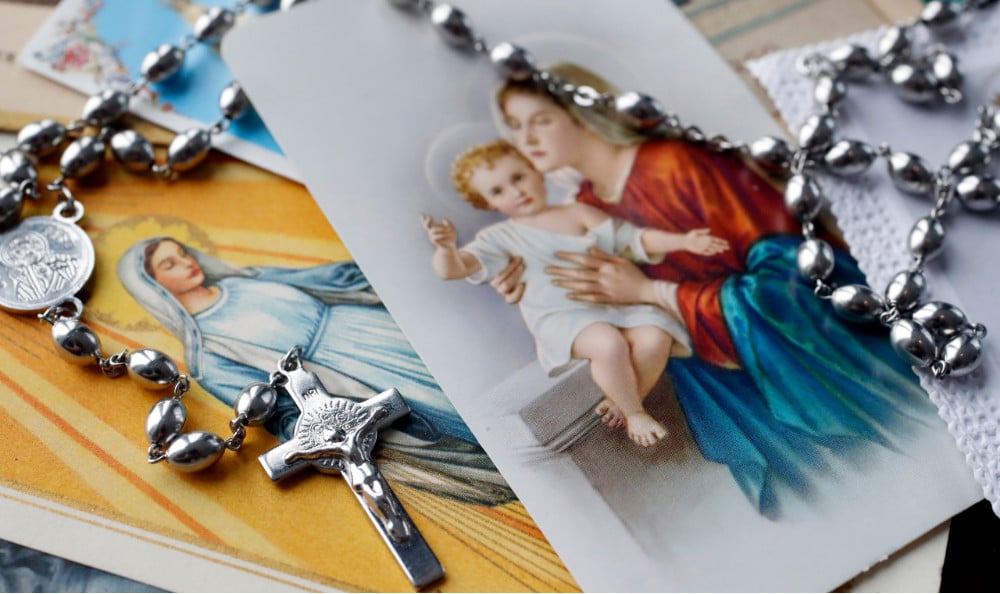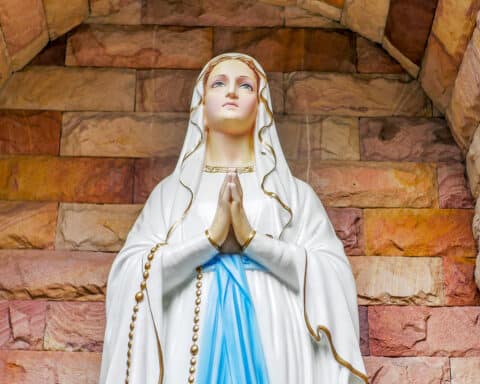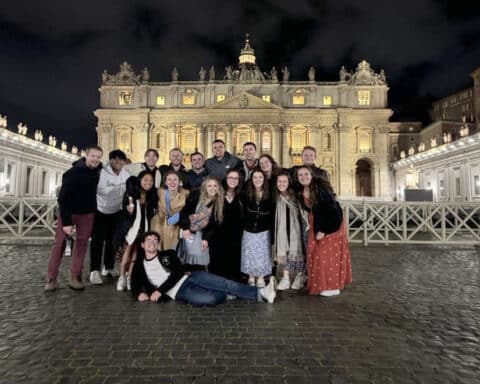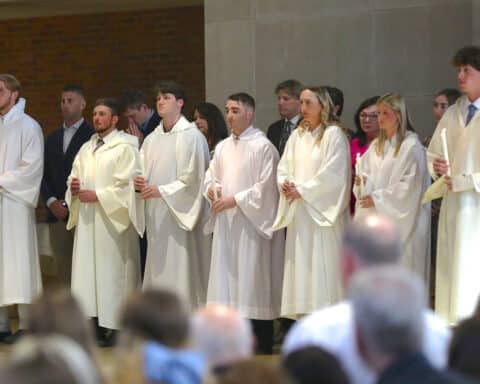While it might have been a catchy title for a 1998 romantic comedy, Catholic colleges and universities are showing today’s younger generation that there really is something about Mary — Our Blessed Mother, the Mother of God, the very immaculate heart of the Catholic faith.
Mary is the eternal Queen of Heaven and Earth, the devil’s greatest conqueror and the one closest to Jesus.
While many Catholic devotions come and go out of popular use, Mary is ever present, even on Catholic college campuses where the waves of secularism threaten inundation, educators and religious told Our Sunday Visitor.
Read more Fall College Section articles here.
“Mary has been receiving renewed attention from our students,” said Jana Bennett, chair of the religious studies department at the University of Dayton in Ohio, a school founded with a Marianist mission and identity.
“For undergraduates, we offer an introductory course — Why Mary?; we also offer an advanced Theology of Mary course. We also now offer graduate certificates in Marian theology for both master’s- and doctorate-level students. The number of graduate students wanting to study Mary has been growing gradually from none five years ago to 5-10 now.”

Mary is a presence on non-Catholic campuses, too, according to Father Bob J. O’Donnell, a Paulist chaplain at the Newman Center at the University of Tennessee.
“Many students pray the Rosary on their own every day. Some do so in small groups after Mass or meetings. They see Mary as a powerful intercessor,” Father O’Donnell said.
Mary is always contemporary and relevant to personal lives and the current world situation, Catholic educators told Our Sunday Visitor.
“Students’ study of Mary is related to this contemporary moment and their own concerns — from thinking through how Mary might help Christians rethink the East/West divide in the Church, to using Marian theology in bioethics, to doing historical studies around the globe on Mary’s importance,” Bennett said. “Our undergrads also participate in an annual Marian forum, which discusses contemporary questions and concerns — like Mary and the pandemic and Mary and immigration.”
Consolation
Mary serves the same needs for college students in 2022 as she has for the faithful over two millennia: help, comfort and strength in times of peril.
With Russia brutalizing Ukraine in unprovoked warfare, Israel and Palestine stoking the Middle-East powder keg, China increasing its threat to Taiwan and abortion roiling America, Mary’s story is compelling and prescient.
At Fatima in 1917, Mary told the three shepherd children that without prayer and penance, “The good will be martyred, the Holy Father will have much to suffer, various nations will be annihilated. In the end, my Immaculate Heart will triumph. The Holy Father will consecrate Russia to me, and she will be converted, and a period of peace will be granted to the world.”
“I think part of the reason for students’ renewed interest is that she offers hope and reassurance in a time of great turbulence, as she has often done over the centuries,” Bennett told Our Sunday Visitor.
Robert Fastiggi, who holds the Bishop Kevin M. Britt Chair of Dogmatic Theology and Christology at Sacred Heart Major Seminary in Detroit, said Marian apparitions over time have an impact appreciated by today’s college students.
“I think there is significant interest among Catholic college and university students on the Blessed Virgin Mary,” Fastiggi said. “This interest is often stimulated by various Marian devotions and apparitions — Guadalupe, Lourdes, Fátima and also Medjugorje, even though it has not been approved by the Church as supernatural.”
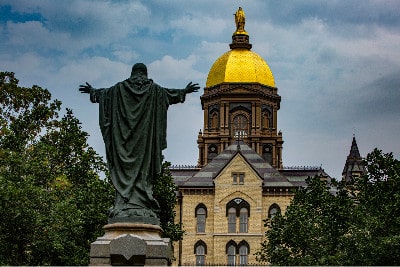
Fastiggi added: “Unfortunately, not all Catholic theology departments offer regular courses in Mariology, but there are signs that the situation is changing. There are many signs of hope about the teaching of Mariology in Catholic colleges, universities and seminaries, but more can be done.”
Mariology needs to be understood as an essential aspect of Catholic dogmatic theology, Fastiggi contended.
He noted the homily of Pope St. Paul VI on April 24, 1970, at the Marian shrine of Our Lady of Bonaria in Cagliari, Sardinia: “If we want to be Christian,” the pope said, “we must also be Marian — that is, we must recognize the essential, vital, providential bond which unites Our Lady with Jesus and which opens to us the way that leads us to him.”
At the University of Dayton, Mary is present to students from Day 1 until they attend the baccalaureate Mass and graduation, four years later, said Father James Fitz, the school’s vice president for mission and rector.
“We aim to make family spirit the distinctive mark of our communities and institutions; growing in the characteristics of Mary, particularly her faith, humility, simplicity and hospitality,” he told Our Sunday Visitor. “We believe living, praying and supporting one another in community enriches our faith and strengthens our ability to meet the challenges of the world. Students understand they are called to use their education and faith to transform the world. Our hope is faith, and community formation will energize all aspects of each person’s personal commitment to learn, lead and serve. Traditionally, Marianists have understood education in schools to be a profound opportunity for building communities of faith.”
Joseph R. LaPlante writes from Rhode Island.

